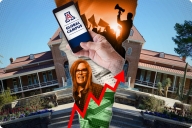You have /5 articles left.
Sign up for a free account or log in.
In the world of college marketing, can a picture be worth a thousand tweets?
It is difficult to appraise social media tools so precisely. But colleges are excited enough about the potential of Pinterest — an image-based social media site that has grown with astonishing speed — to keep their institutional brand on the minds of prospective students and alumni that many have scrambled to establish a “presence” there, even as the value of the site as a marketing tool remains hazy. Others have hung back, leery of investing too heavily in trendy platforms before their utility can be properly pinned down.
Pinterest, a "virtual pinboard” where users can create profiles by accruing illustration-based "pins” that represent their interests and affiliations, is nowhere near as large as other social media sites that college communications staffers have been wrangling for the better part of a decade. But its rate of growth has been difficult to ignore. Pinterest has fewer than half a million users last May; by January it had more than 11.7 million, according to an analysis by the tech consulting firm Modea. That makes Pinterest one of the fastest-growing websites ever.
While the site nevertheless remains orders of magnitude smaller than Facebook and Twitter, which colleges currently rate as the top two social sites for accomplishing their “messaging” goals, Pinterest’s essential focus on visual storytelling might give it a trump card over its largely text-focused forebears, says Aaron Jaco, a digital media specialist in the marketing office at Drake University.
“Because of its visual nature it feels uncluttered compared to the text-heavy platforms like Facebook and Twitter,” says Jaco.
The platform has prompted some college offices to articulate messages to students in a more visual way. The University of Minnesota has begun using Pinterest to promote campus events. The University of Pennsylvania's Career Services Office has posted "pins" that link to items on its own blog, as well as outside articles on fashion tips for interviewees.
Drake has made a particularly strong play on Pinterest. Jaco, a 2007 Drake graduate, runs the university’s Pinterest page with help from several interns. The university’s Pinterest page has 17 “boards,” each of which contains a gallery of image “pins” tied together by a theme -- “Rad room décor,” “Adorbs bulldogs" (Drake's mascot is a bulldog), “Study inspiration,” etc. There are boards devoted to study abroad, campus athletics, food and fashion. The university controls the content of its own page, but users can suggest their own Drake-themed pins and re-post Drake's pins on their own pinboards.
The strategy is purposefully informal, Jaco says. “We threw it on to the student interns and said, 'Can you just experiment with this?' ” he says. The idea was to avoid the temptation to be heavy-handed with their institutional messaging. In general Facebook and Twitter are “too cluttered with brands who are just selling at you,” says Jaco. Drake was looking for something more whimsical and human — more like a lifestyle magazine than a viewbook.
“The thing we don’t want to hear from our alums is that they’re only hearing about us and only thinking about us when we want money from them,” says Jaco, a 2007 graduate of the university. “The more we can engage in a friendly, non-sales way, the better.”
Pinterest’s orientation to “authenticity” presents a new sort of challenge to communications staffers, says Ma’ayan Plaut, the social media coordinator at Oberlin College. “This shift in mindset from self-promotion to using other means to define your views in the context of the great world … shifts the perspective of promotion from things we want/need to tell folks about ourselves and rather, highlight other creators and collaborators who support similar ideas, causes and creations to us,” Plaut wrote in a blog post about Pinterest for the Council for the Advancement and Support of Education.
Pinterest’s strength as a marketing tool — the opportunity to casually stimulate an audience with visual ideas without tying it with an explicit message — may also be its greatest weakness. The need to be "human" (there is no user category for companies or organizations, only "people") can be stifling from the perspective of return-on-investment. For example, Drake is determined not to alienate students by trying to channel them toward buying bookstore products, so none of the pins on the “Rad dorm décor” board refer students to items they can buy through the Drake bookstore. Nor does Drake have any intention of accepting money from outside makers of dorm-room accouterments in exchange for referrals to their site.
“We’ve sort of come to a point where we’ve defined our goal as being engagement and brand impressions, rather than some of the measurements that more sales-oriented management are using, like referral traffic back to their website,” says Jaco.
But unlike referrals, “engagement” is difficult to measure in any quantitative sense. Metrics such as “likes” and “re-pins” are “kind of foggy” in terms of providing insight into whether an institution’s Pinterest page is worth the time and labor that goes into curating it, says Jaco.
The catch is that it is difficult to merely dabble in any social media platform, says Bill Keller, a new media specialist at Muhlenberg College. The one way a college can guarantee a negligible return on the time and energy it puts into crafting and executing a Pinterest strategy, he says, is to make a timid investment.
“It’s the sort of thing where, if you don’t update it fairly regularly, your voice is going to get lost,” says Keller. “If you don’t continue to post regularly, then the account will go stale and people will just think it is a dead account.”
The challenge is that because of their visual nature, Pinterest accounts are difficult to keep well-fed. It is fairly easy to dash off a tweet or a Facebook status update, Keller says. But “with Pinterest you’re going to need a regular visual to tie into it,” he says. Images have the potential to have the clout of a thousand tweets, but compelling ones might be more difficult to procure.
So Keller and Muhlenberg are waiting for a picture of what an effective Pinterest strategy looks like to come more fully into focus. Worse than missing the boat, they have concluded, would be jumping enthusiastically aboard before realizing they do not know how to drive it. “When we do jump in,” Keller says, “I want to make sure it’s a strong footprint with solid intent behind it.”
For the latest technology news and opinion from Inside Higher Ed, follow @IHEtech on Twitter.








